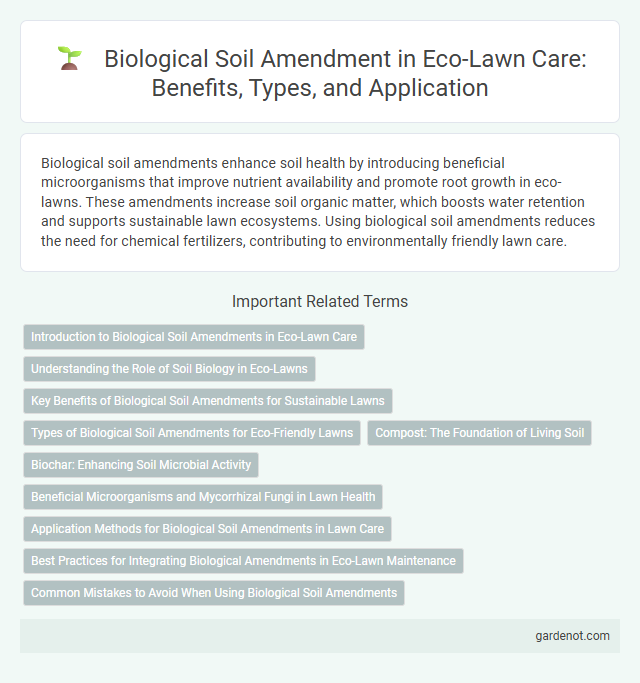Biological soil amendments enhance soil health by introducing beneficial microorganisms that improve nutrient availability and promote root growth in eco-lawns. These amendments increase soil organic matter, which boosts water retention and supports sustainable lawn ecosystems. Using biological soil amendments reduces the need for chemical fertilizers, contributing to environmentally friendly lawn care.
Introduction to Biological Soil Amendments in Eco-Lawn Care
Biological soil amendments play a crucial role in eco-lawn care by enhancing soil health, structure, and nutrient availability through natural processes. These amendments, which include compost, humic substances, and beneficial microorganisms, improve microbial activity and promote sustainable grass growth without synthetic chemicals. Incorporating biological soil amendments helps in building resilient soil ecosystems, leading to greener, healthier lawns while reducing environmental impact.
Understanding the Role of Soil Biology in Eco-Lawns
Biological soil amendments enhance eco-lawn health by introducing beneficial microorganisms that improve soil structure and nutrient cycling. These amendments stimulate microbial activity, increasing organic matter decomposition and promoting root growth for drought-resistant turf. Understanding soil biology in eco-lawns leads to sustainable lawn care practices that reduce chemical inputs and support ecosystem balance.
Key Benefits of Biological Soil Amendments for Sustainable Lawns
Biological soil amendments enhance soil health by increasing microbial activity, improving nutrient availability, and promoting root growth, which leads to thicker, more resilient eco-lawns. They contribute to sustainable lawns by reducing the need for synthetic fertilizers and pesticides, thereby minimizing environmental impact and supporting biodiversity. Enhanced soil structure and moisture retention from these amendments also improve drought resistance and lawn durability over time.
Types of Biological Soil Amendments for Eco-Friendly Lawns
Types of biological soil amendments for eco-friendly lawns include compost, which enriches soil with organic matter and beneficial microbes, and biochar, known for enhancing soil aeration and moisture retention. Mycorrhizal fungi inoculants improve root growth and nutrient uptake by forming symbiotic relationships with grass roots. Additionally, humic substances derived from decomposed organic material boost soil fertility and stimulate microbial activity, promoting a healthier lawn ecosystem.
Compost: The Foundation of Living Soil
Compost serves as the foundation of living soil by enriching it with essential organic matter and beneficial microorganisms that enhance nutrient availability and soil structure. Biological soil amendments like compost improve water retention, promote root development, and stimulate microbial activity crucial for a healthy eco-lawn. This natural process supports sustainable lawn growth while reducing the need for chemical fertilizers and minimizing environmental impact.
Biochar: Enhancing Soil Microbial Activity
Biochar significantly improves soil microbial activity by providing a stable habitat for beneficial microbes and enhancing nutrient retention in eco-lawn soils. Its porous structure increases oxygen flow and water holding capacity, fostering a thriving microbial ecosystem that supports plant health and soil fertility. Integrating biochar as a biological soil amendment promotes sustainable lawn management by boosting natural processes and reducing the need for chemical fertilizers.
Beneficial Microorganisms and Mycorrhizal Fungi in Lawn Health
Beneficial microorganisms and mycorrhizal fungi serve as essential biological soil amendments in eco-lawn management, enhancing nutrient cycling and improving soil structure. These microscopic organisms form symbiotic relationships with grass roots, increasing water absorption and resistance to drought and pathogens. Incorporating these natural agents into lawns boosts overall plant vitality and reduces the dependency on chemical fertilizers and pesticides.
Application Methods for Biological Soil Amendments in Lawn Care
Applying biological soil amendments in eco-lawn care involves techniques such as topdressing, slurry application, and soil injection to enhance microbial activity and improve soil structure. Topdressing distributes organic matter evenly over the lawn surface, promoting nutrient retention and moisture conservation. Soil injection places amendments directly into the root zone, accelerating nutrient availability and supporting healthy turfgrass growth.
Best Practices for Integrating Biological Amendments in Eco-Lawn Maintenance
Incorporating biological soil amendments such as compost, biochar, and beneficial microbes enhances soil structure, nutrient availability, and microbial diversity in eco-lawn maintenance. Applying amendments during early spring or fall ensures optimal microbial activity and nutrient uptake. Regular soil testing guides precise amendment rates, preventing nutrient imbalances and promoting sustained eco-lawn health.
Common Mistakes to Avoid When Using Biological Soil Amendments
Applying biological soil amendments without proper soil testing can lead to nutrient imbalances and ineffective microbial activity in eco-lawns. Overusing amendments or incorporating synthetic fertilizers simultaneously may disrupt the natural soil microbiome, reducing long-term soil health. Ensuring correct application rates and timing based on soil conditions is crucial to maximize the benefits of biological soil amendments.
Biological soil amendment Infographic

 gardenot.com
gardenot.com